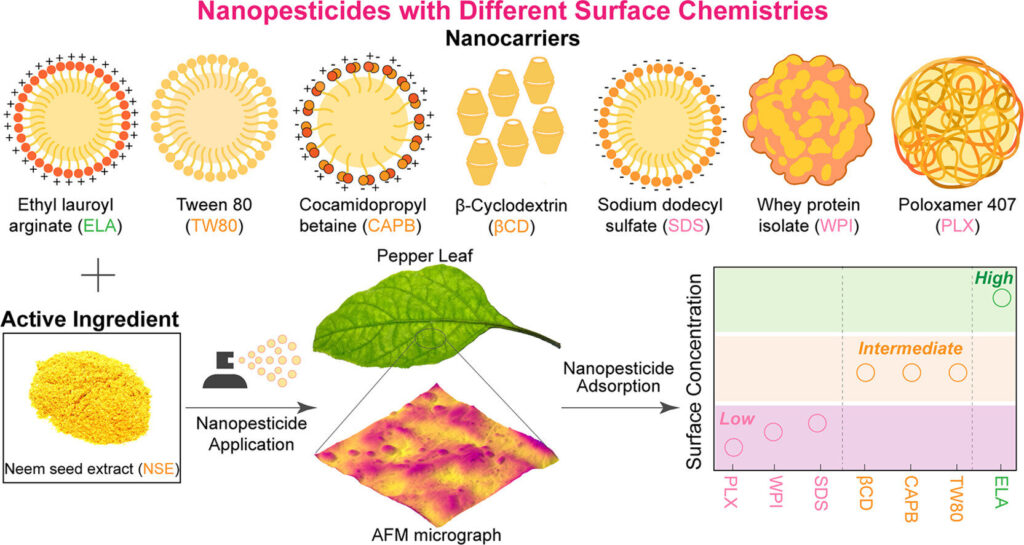Pesticides can be made more effective and environmentally friendly by improving how they stick to plant surfaces, thanks to new research led by Dr. Mustafa Akbulut, professor of chemical engineering at Texas A&M University.
Akbulut and his research group have developed an innovative pesticide delivery system called nanopesticides. These tiny technologies, developed through a collaboration between Texas A&M University’s engineering and agricultural colleges, Dr. Luis Cisneros-Zevallo, professor of Horticultural Science and Dr. Younjin Min, professor of Chemical Environ Engineering at University of California, Riverside, could change how we use pesticides.
“The U.S. is a world leader in agricultural production, feeding not just our nation but much of the world. Yet we are using pesticides in a way that is simply not sustainable—with a substantial fraction not reaching its intended target,” said Akbulut. “Our research shows that by optimizing the surface chemistry of pesticide carriers, we can make these essential crop protection tools more efficient.”
The team studied different types of nanopesticide carriers, testing their “stickiness” to pepper leaves, a representative model for many important crops. They discovered that the carrier’s surface chemistry plays an important role in how well the nanopesticide adheres to the plant.
Nanopesticides encapsulate the active pesticide ingredients within microscopic carriers. Think of it like delivering a targeted package directly to the pest, minimizing collateral damage. This research focused on understanding how these nanopesticides interact with plant surfaces, a crucial step in maximizing their effectiveness.
Pesticides are essential for protecting crops from pests and diseases, and without them, we would lose a huge portion of our harvests—up to 70–80% of fruits, 40–50% of vegetables, and 20–30% of cereals.
However, current pesticide application methods are incredibly inefficient. More than 80–90% of sprayed pesticides miss their target entirely, ending up in the environment where they can cause harm. This waste is not only bad for the planet, but it is also economically unsustainable.
This compound, which Akbulut and Yashwanth Arcot, Ph.D candidate discuss in their paper published in Surfaces and Interfaces Journal, is a mixture of ethyl lauroyl arginate (ELA), a food preservative compound, and neem seed extract.
Arcot’s interest in the research focuses on nanopesticide chemistry to ensure a higher targeting ability and the strong correlation between the nanopesticide carrier and its adsorption behavior.
Akbulut believes that by using nanopesticide, he can increase the efficacy by better targeting the plant surface. Akbulut and his team aim to achieve this by taking various pesticides and modifying their interfacial properties using carriers that are best suited to interact with the plant surface characteristics.
Overall, the goal of the research is to find a way for more efficient and environmentally friendly pesticide formulations that are sustainable for agricultural practices and global food security.
Discover the latest in science, tech, and space with over 100,000 subscribers who rely on Phys.org for daily insights.
Sign up for our free newsletter and get updates on breakthroughs,
innovations, and research that matter—daily or weekly.
“This study addresses a critical challenge in sustainable agriculture by optimizing nanopesticide systems to enhance efficacy, reduce environmental pollution, and minimize impacts on non-target organisms and human health,” Arcot said.
Neem seed is a naturally occurring pesticide that comes from the seeds of the neem tree and is used to control pests and diseases on crops. The extract from a neem seed tree grows mostly in India but is organic pesticide management.
“Organic pesticides use this formulation, and we also use this molecule in the center. Although the carriers are different, the active ingredient inhibits or inactivates the pest.”
According to the paper, among various types of pesticides, nanopesticides have shown to be an advanced crop protection strategy that relies on agricultural technology, nanotechnology, and materials chemistry.
Akbulut said that this discovery has profound implications for the future of agriculture. By tailoring the surface chemistry of nanopesticides, scientists can optimize their effectiveness, ensuring that more of the pesticide reaches the target pest and less ends up polluting the environment.
“For farmers or industry who are using the pesticides, they will clearly understand the value of this research,” Akbulut said. “Pesticides, in general, are considered bad for the environment; using neem seed extract ensures crop survival from pests and is non-toxic for consumption.”


